|
Model
Aircraft (fixed wing) – Jetex 150 / Jetmaster
Click on any image to view or download the construction plan.
|
Jet
Tube by Richard Wood

Click image for quarter-size plan
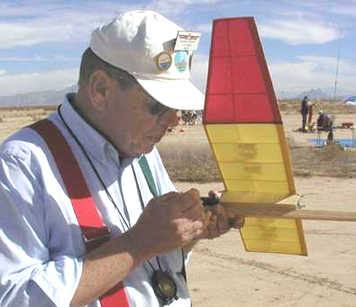  From Model Aviation Magazine, Oct. 1976.
From Model Aviation Magazine, Oct. 1976.
The photo shows Al Lidberg preparing
his Jet Tube for flight at the SW Regionals, Eloy, in January 2002. It's also
the plane Al's #1 son used to set an AMA 'Rocket'/Jetex record about 20 years
previously!
A printed full-size plan is available from
Allen Hunt.
Thanks to Ben Nead for the photo and Allen Hunt
for the plan.
|

X-15 by Paul Del Gatto
Click image for plans
and construction notes
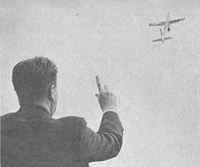  From Model Airplane News, May 1960.
From Model Airplane News, May 1960.
Paul Del Gatto writes:
"For less than two bits worth of material you can build just about the fastest climbing model flying machine you've ever seen - and we make no exceptions - in this slick, dressed-up profile version of a Jetex powered "X-15".
"Both of the first two X-15's we made were lost out of sight each on its first flight. These were no back yard flights either. Of course we don't recommend losing them. The model is easy. enough to replace but you'd be out a Paa-Loader "150" engine.
"Using two pellets of fuel, the model will climb to a height of 400 to 500 feet and, though the glide is not comparable to that of a free-flight gas model, the X-15 still requires as much room as the average free-flight - something we did not foresee when we built our test job. Although the wing area is small, gliding angle and speed is such that damage upon landing is extremely unlikely. Moreover, the model is so easy to build that we suggest making two or three at a time."
Thanks to Grif Ingram for a copy of the article.
|

Rocket
A-Go-Go
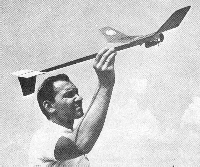  This plane, designed by Paul Crowley for a Jetex
150 PAA-Loader, is a good compromise
of size and wing loading. Quick to build and
light, it's also warp resistant. Motor
is safety wired to the plane. Launch
from hand with a gentle push at about
40 degrees, waiting for thrust to build
up. Power circle should be same as the
glide. Click the thumbnail to see (or
download) the
full-size, 1:1 scale plan.
This plane, designed by Paul Crowley for a Jetex
150 PAA-Loader, is a good compromise
of size and wing loading. Quick to build and
light, it's also warp resistant. Motor
is safety wired to the plane. Launch
from hand with a gentle push at about
40 degrees, waiting for thrust to build
up. Power circle should be same as the
glide. Click the thumbnail to see (or
download) the
full-size, 1:1 scale plan.
|

Jetsport
  An all balsa, easy to
build from scratch plane, designed for
a Jetex 150 size motor. Click the
thumbnail to see (or download) the
full-size, 1:1 scale plan.
An all balsa, easy to
build from scratch plane, designed for
a Jetex 150 size motor. Click the
thumbnail to see (or download) the
full-size, 1:1 scale plan.
|

Heat
Seeker III
  A 1966 design for Jetex 150
motors, it won first prize in the USAF
World Wide competition for that year.
Bilgri multispar airfoil in the wing,
flatbottom stab. Has no tendencies to
spin out of thermals, and has a very
stable glide. Light, warp-free,
straight grain balsa selection is
essential. Avoid all warping in
construction. Uses 3 coats of 60:40
dope. Test glide with empty engine.
Click the thumbnail to see (or
download) the
full-size, 1:1 scale plan.
A 1966 design for Jetex 150
motors, it won first prize in the USAF
World Wide competition for that year.
Bilgri multispar airfoil in the wing,
flatbottom stab. Has no tendencies to
spin out of thermals, and has a very
stable glide. Light, warp-free,
straight grain balsa selection is
essential. Avoid all warping in
construction. Uses 3 coats of 60:40
dope. Test glide with empty engine.
Click the thumbnail to see (or
download) the
full-size, 1:1 scale plan.
|

Sidewinder
  A novel stick-and-tissue model
for the PAA-Loader 150. In this design
the motor is at the center of gravity
and the center of drag, with the
fuselage tilted to accommodate. Design
by Gerald Zeigenfuse, and featured in
Flying Models magazine,
April-May 1960, p 21. Click the
thumbnail to see (or download) the
full-size, 1:1 scale plan .
Complete assembly and flying
instructions are posted to our
archives. Click
here to read the entire article.
Thanks to Peter Brown for sharing the
magazine with us.
A novel stick-and-tissue model
for the PAA-Loader 150. In this design
the motor is at the center of gravity
and the center of drag, with the
fuselage tilted to accommodate. Design
by Gerald Zeigenfuse, and featured in
Flying Models magazine,
April-May 1960, p 21. Click the
thumbnail to see (or download) the
full-size, 1:1 scale plan .
Complete assembly and flying
instructions are posted to our
archives. Click
here to read the entire article.
Thanks to Peter Brown for sharing the
magazine with us.
|

Sipa
200
  From the French modelling
magazine Le Modèle Réduit
d'Avion, Oct. 1953, a really well
designed plan by E. Chelle for a Jetex
PAA-Loader 150 or 100 engine with
augmenter tube. This one, with a short
augmenter section, will likely have
more "thrust augmentation," according
to tests, than a full-length tube. The
plan is well-detailed, nicely drawn,
and large. Click here to view or
download the
full-size, 1:1 scale plan (part 1)
-
part 2 -
part 3.
Outline views and article.
From the French modelling
magazine Le Modèle Réduit
d'Avion, Oct. 1953, a really well
designed plan by E. Chelle for a Jetex
PAA-Loader 150 or 100 engine with
augmenter tube. This one, with a short
augmenter section, will likely have
more "thrust augmentation," according
to tests, than a full-length tube. The
plan is well-detailed, nicely drawn,
and large. Click here to view or
download the
full-size, 1:1 scale plan (part 1)
-
part 2 -
part 3.
Outline views and article.
The French instructions
have been preserved, but are not
translated.
|

Swif-f-f-t
  This Gerald R. Zeigenfuse
model uses a PAA-Loader 150. Click the
thumbnail to see (or download) the
full-size, 1:1 scale plan.
This Gerald R. Zeigenfuse
model uses a PAA-Loader 150. Click the
thumbnail to see (or download) the
full-size, 1:1 scale plan.
|

Convair
Delta
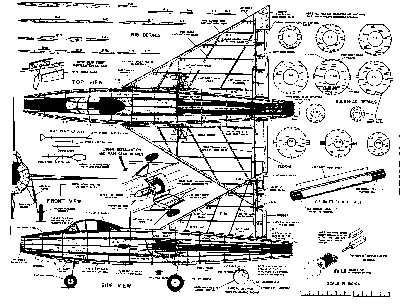  This augmenter tube model
requires a Jetex 150 PAA-Loader. Click
the thumbnail to see (or download) the
full-size, 1:1 scale plan.
This augmenter tube model
requires a Jetex 150 PAA-Loader. Click
the thumbnail to see (or download) the
full-size, 1:1 scale plan.
|

Boeing Dyna-Soar
  The USAF's 1960's Dyna-Soar (stands for DYNAmic SOARing) spaceplane was
to be the first manned spacecraft to reach the hardware stage. The program was cancelled in 1963
with only one non-flying mock-up completed. Read more about the project on Aerospaceguide.net
and on the Deep Cold site.
The USAF's 1960's Dyna-Soar (stands for DYNAmic SOARing) spaceplane was
to be the first manned spacecraft to reach the hardware stage. The program was cancelled in 1963
with only one non-flying mock-up completed. Read more about the project on Aerospaceguide.net
and on the Deep Cold site.
Here's a model of it that uses an
augmenter tube, for a PAA-Loader 150
motor. Click the thumbnail to see (or
download) the
1:4 scale plan.
|

Boeing Dyna-Soar –
Version 2
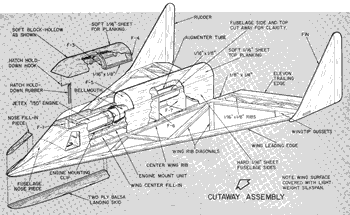 
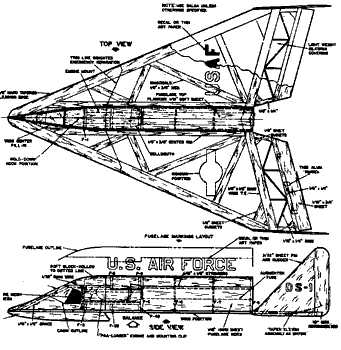  |
Here's another Dynasoar design that
also uses an augmenter tube, for a PAA-Loader
150 motor. This plan is from
July 1962. The designer called for
Silkspan tissue and colored dopes, used
sparingly. Balsa hardness, also
specified, should be followed as well.
Augmenter tube is "rolled to shape from
0.005" [0.127 mm] aluminum 2-5/8" [6.67
cm] wide, plus allowance for an
overlapping seam."
As for flight, the
designer said: "Test glide model,
launching it by the landing skid. For
best performance model should be
trimmed with elevons raised 5° to
10° [13-25 cm]. Make these initial
tests over soft grass and avoid windy
weather. Aim the model at a ground
spot about 50' [15 m] ahead in these
hand glides. When flying with power,
point nose up slightly, launch with the
same force as for hand gliding.
Further adjustments are carried out by
bending individual elevons and/or the
trim tab of the left fin. Never bend
an elevon down. If more turn control
is desired, or if a smoother,
coordinated turn-and-bank is needed,
bend the fin trim-tab in conjunction
with elevon adjustment. Be sure to
select plenty of flying space because
your Dyna-Soar will live up to is
name."
Click the upper thumbnail to view or
download a
cutaway construction diagram and the lower thumbnail to view or
download the
1:3 scale plan.
Plans courtesy Tim Atkins.
|
|



|
Ja-Tex Rocket by Reid Simpson, of the USAF team
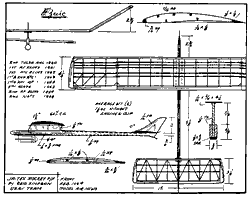  In eight national and regional contests over five years, Ja-tex Rocket gained four first placings and three second. In eight national and regional contests over five years, Ja-tex Rocket gained four first placings and three second.
Plan from Zaic Model Aeronautic Year Book, 1964-65.
Click image to
see (or download) the
plan.
|

|
Sizzlestick by Tem Johnson
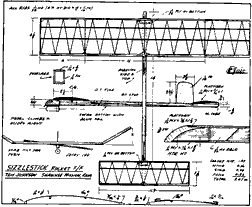  Tem Johnson also designed a winning PAA-load model, but with Sizzlestick he was able to design a pure duration free-flight model, with the constraints of the PAA-load contest rules. Tem Johnson also designed a winning PAA-load model, but with Sizzlestick he was able to design a pure duration free-flight model, with the constraints of the PAA-load contest rules.
Plan from Zaic Model Aeronautic Year Book, 1964-65.
Click image to
see (or download) the
plan.
|

|